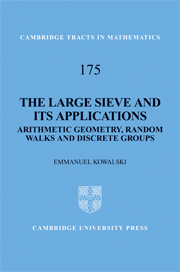Book contents
- Frontmatter
- Contents
- Preface
- Acknowledgments
- Prerequisites and notation
- 1 Introduction
- 2 The principle of the large sieve
- 3 Group and conjugacy sieves
- 4 Elementary and classical examples
- 5 Degrees of representations of finite groups
- 6 Probabilistic sieves
- 7 Sieving in discrete groups
- 8 Sieving for Frobenius over finite fields
- Appendix A Small sieves
- Appendix B Local density computations over finite fields
- Appendix C Representation theory
- Appendix D Property (T) and Property (τ)
- Appendix E Linear algebraic groups
- Appendix F Probability theory and random walks
- Appendix G Sums of multiplicative functions
- Appendix H Topology
- References
- Index
1 - Introduction
Published online by Cambridge University Press: 05 October 2009
- Frontmatter
- Contents
- Preface
- Acknowledgments
- Prerequisites and notation
- 1 Introduction
- 2 The principle of the large sieve
- 3 Group and conjugacy sieves
- 4 Elementary and classical examples
- 5 Degrees of representations of finite groups
- 6 Probabilistic sieves
- 7 Sieving in discrete groups
- 8 Sieving for Frobenius over finite fields
- Appendix A Small sieves
- Appendix B Local density computations over finite fields
- Appendix C Representation theory
- Appendix D Property (T) and Property (τ)
- Appendix E Linear algebraic groups
- Appendix F Probability theory and random walks
- Appendix G Sums of multiplicative functions
- Appendix H Topology
- References
- Index
Summary
Presentation
Classical sieve theory is concerned with the problem of the asymptotic evaluation of averages of arithmetic functions over integers constrained by congruence restrictions modulo a set of primes. Often the function in question is the characteristic function of some interesting sequence and the congruence restrictions are chosen so that those integers remaining after the sieving process are, for instance, primes or ‘almost’ primes.
If the congruence conditions are phrased as stating that the only integers n which are allowed are those with reduction modulo a prime p not in a certain set Ωp, then a familiar dichotomy arises: if Ωp contains few residue classes (typically, a bounded number as p increases), the setting is that of a ‘small’ sieve. The simplest such case is the detection of primes with Ωp = {0}. If, on the other hand, the size of Ωp increases with p, the situation is that of a ‘large’ sieve. The first such sieve was devised by Linnik to investigate the question of Vinogradov of the size of the smallest quadratic non-residue modulo a prime.
There have already been a number of works extending ‘small’ sieves to more general situations, where the objects being sifted are not necessarily integers. One may quote among these the vector sieve of Brüdern and Fouvry [17], with applications to Lagrange's theorem with almost prime variables; the ‘crible étrange’ of Fouvry and Michel [42], with applications to sign changes of Kloosterman sums, and Poonen's striking sieve procedure for finding smooth hypersurfaces of large degree over finite fields [105] (which we describe briefly in Example 4.11).
- Type
- Chapter
- Information
- The Large Sieve and its ApplicationsArithmetic Geometry, Random Walks and Discrete Groups, pp. 1 - 7Publisher: Cambridge University PressPrint publication year: 2008



